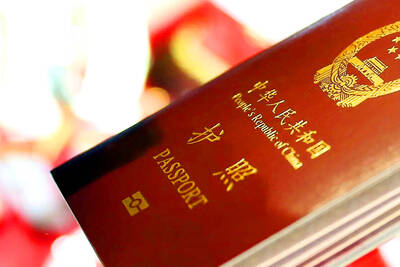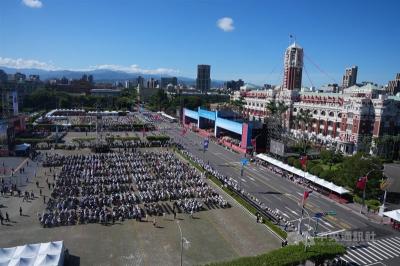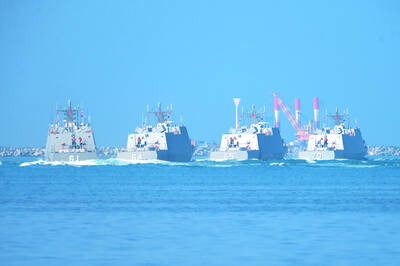Japan will start an aggressive push to market its mobile technology abroad, especially the nation’s popular “wallet phone,” a government official said yesterday.
Although Japan boasts some of the most sophisticated cellphones in the world, delivering high-speed Internet connections, digital TV broadcasts and video downloads, the nation has failed to make its handsets, wireless technology and mobile services hits outside of Japan.
The latest initiative spearheaded by the government with an industry group of Japanese carriers and manufacturers is an effort to help Japan catch up in wooing global users, said Masayuki Ito, official at the Ministry of Internal Affairs and Communications.
Among the wireless innovations Japan hopes to peddle is the wallet phone. The technology relies on a tiny computer chip called FeliCa, embedded in each cellphone, which communicates with a reader-device at stores, train stations and vending machines for cashless payments.
FeliCa was developed by Japanese electronics and entertainment company Sony Corp. Such technology is more common in smart cards, popular in Singapore and parts of Europe. But Japan hopes to market the technology abroad for cellphones.
In Japan, wallet phones have been available since 2004, introduced by top mobile carrier NTT DoCoMo. Most recent handset models here have the wallet function.
Older Japanese technology had compatibility problems with other global standards, but new third-generation (3G) technology allows new products to be used outside the country, and can be more easily adapted to overseas products.
Japan leads the rest of the world in 3G cellphone proliferation, with nearly 104 million 3G handsets in use, or about 90 percent of cellphones being used in Japan.
Japan also hopes to promote overseas other kinds of wireless technology, including 3G mobile phones with GSM, or Global System for Mobile communications, which allows the same phone to be used in most countries.
Ito acknowledged that wireless technology must adapt to differing social needs around the world. Wallet phones have been hits in Japan because of omnipresent convenience stores and vending machines, as well as the relative lack of credit card use. But conditions in other nations may differ.
“Some critics say Japanese mobile technology tends to be quirky like the Galapagos Islands,” he said, referring to the isolated Pacific islands reputed to have undergone unusual evolutionary changes in a reference to the incompatibility of older Japanese cellphones and their quirky services.
“But Asian nations such as Taiwan and South Korea have for years expressed great interest in Japanese cellphones,” he added.
Other technologies that Japan hopes to promote abroad are more futuristic such as fourth-generation wireless, Ito said.
Details and budget plans for the government effort are being outlined in the next few months, but a proposal was approved at a ministry meeting last month.

The Ministry of the Interior (MOI) is to tighten rules for candidates running for public office, requiring them to declare that they do not hold a Chinese household registration or passport, and that they possess no other foreign citizenship. The requirement was set out in a draft amendment to the Enforcement Rules of the Public Officials Election and Recall Act (公職人員選舉罷免法 ) released by the ministry on Thursday. Under the proposal, candidates would need to make the declaration when submitting their registration forms, which would be published in the official election bulletin. The move follows the removal of several elected officials who were

The Republic of China (ROC) is celebrating its 114th Double Ten National Day today, featuring military parades and a variety of performances and speeches in front of the Presidential Office in Taipei. The Taiwan Taiko Association opened the celebrations with a 100-drummer performance, including young percussionists. As per tradition, an air force Mirage 2000 fighter jet flew over the Presidential Office as a part of the performance. The Honor Guards of the ROC and its marching band also heralded in a military parade. Students from Taichung's Shin Min High School then followed with a colorful performance using floral imagery to represent Taiwan's alternate name

FOUR DESIGNATED AREAS: Notices were issued for live-fire exercises in waters south and northwest of Penghu, northeast of Keelung and west of Kaohsiung, they said The military is planning three major annual exercises across the army, navy and air force this month, with the navy’s “Hai Chiang” (海強, “Sea Strong”) drills running from today through Thursday, the Ministry of National Defense said yesterday. The Hai Chiang exercise, which is to take place in waters surrounding Taiwan, would feature P-3C Orion maritime patrol aircraft and S-70C anti-submarine helicopters, the ministry said, adding that the drills aim to bolster the nation’s offshore defensive capabilities. China has intensified military and psychological pressure against Taiwan, repeatedly sending warplanes and vessels into areas near the nation’s air defense identification zone and across

A Chinese takeover of Taiwan would severely threaten the national security of the US, Japan, the Philippines and other nations, while global economic losses could reach US$10 trillion, National Security Council Deputy Secretary-General Lin Fei-fan (林飛帆) wrote in an article published yesterday in Foreign Affairs. “The future of Taiwan is not merely a regional concern; it is a test of whether the international order can withstand the pressure of authoritarian expansionism,” Lin wrote in the article titled “Taiwan’s Plan for Peace Through Strength — How Investments in Resilience Can Deter Beijing.” Chinese President Xi Jinping’s (習近平) intent to take Taiwan by force